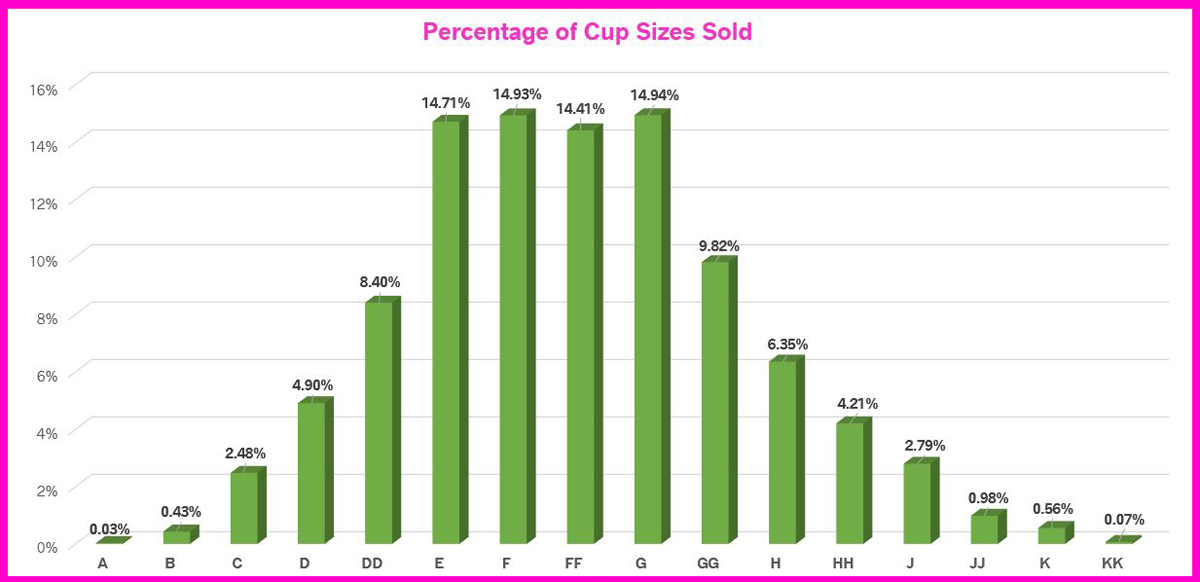Hello Everyone,
We are moving forward with our annual statistical discussion to examine the sales of each cup size. Be sure to check out both our demographics post as well as our band size breakdown. Keep in mind, cup size means nothing without a band to give it context, but for the purposes of our analysis, I want to compare how sales across cup sizes differ. Below is a graph for the sales distribution of each cup size. (Note: For my discussion, I will refer to cup sizes using the UK sizing system.)
Observations & Notes:
- Cup sizes E through G account for roughly 59% of our sales, down 3% from last year, and if we include D and DD cups, the number jumps to 72.3%, also down from last year.
- The GG+ cup sizes account for over 24% of our sales, up 2% from last year.
- Traditional mainstream cup sizes A-DDD/E account for nearly 31% of our total sales.
- Best-selling cup sizes E-G are all within half a percent of each other with the UK G cup (US I) edging out the competition. Last year, it was the UK F (US G).
The B-DDD/E Cup Sizes
Every year I reiterate that our initial inventory focused on DD+ sizes so as not to overlap too much with nearby Victoria’s Secret; however, after the store gained momentum and a foothold in the area, we saw a surge in customers wanting a greater selection in the B-DD market. We responded by expanding our inventory, and I think the improved distribution of sizes and broader customer base demonstrate the wisdom to this decision. Once we became known as “the bra store” rather than “the bra store for big boobs,” our customer base diversified to include a range of sizes, all of which needed better support garments. Since we receive a lot of referrals from Soma, Lane Bryant, and Catherine’s, I think it’s natural that DDD+ cup sizes are still better selling than more traditionally mainstream ones.
The A Cup Dilemma
As the graph indicates, we have sold more KK cups than A cups, but I know next year will see an increase because of our recent brand expansion to American Breast Care. After a prolonged search and debate, we decided the mastectomy company was the best solution to the ongoing issues faced by people in 38+ bands wearing AA-C cups. To be totally honest, I am not sure how to account for the practical absence of this customer in 32-36 bands other than they may be fine with bras from other local retailers. I typically only carry B+ cups in the store in 30-36 bands now because they do not sell, but we can order a broad selection.
GG+ Cup sizes
Our sales for GG+ cups have never been predictable. It’s not unusual for a week to pass by without a single GG+ customer and then have three people in the same size range walk into the shop within an hour. However, over the last three years, sales continue to grow, and with improved options available from manufacturers as well as powerhouse brands Anna Pardal and Comexim offering alterations, we’re seeing these customers coming back for basics in addition to fun fashion styles. Bringing in fresh Cleo styles like Minnie and Marcie as well as the stellar Panache Envy and Clara have fueled sales, but once we hopped on the Polish bra bandwagon, the influx of orders skyrocketed. In last year’s post, I actually predicted the sales for this demographic would continue to grow, which it certainly has. To me, this is a classic case of a manufacturer and retailer meeting customers’ needs and reaping the benefits. Imagine how much sales could increase in some of the other cup sizes if there were better options available! (I’m looking at you 28-30 A-C market.)
The Best-Sellers
Clearly, the sizes we sell the most fall within the standard D-G cup size range, which intuitively makes sense. Most dress patterns allow for a 5 to 9″ difference between waist and bust—an allowance in line with the D-G market. What interests me while examining this year’s statistics is how close in percentage all of the best selling cup sizes continue to grow. The difference in sales between the UK F and G cups is literally less than $25 in total sales. That’s it. As the years have gone by, these sizes have slowly equalized, and I anticipate they will stay this way in the future too.
KK+ Cups
In the last six months, I have referred about twenty people to Ewa Michalak because UK manufacturers simply do not go high enough in the cup. As a business person, I recognize that you have to produce what will sell well, but the demand is there. These women are desperate to find something—anything—that fits. Panache, in particular, could capture the needs of the market well if they worked with these customers directly to ensure the cups were deep enough, especially toward the center, and that the wires were not overly tall on the sides. Fashion colors are not essential to start either, but more manufacturers need to acknowledge the existence of this market and work to address it.
What do you think? Were you surprised at all by the cup size distribution?
Erica


Leave a Reply